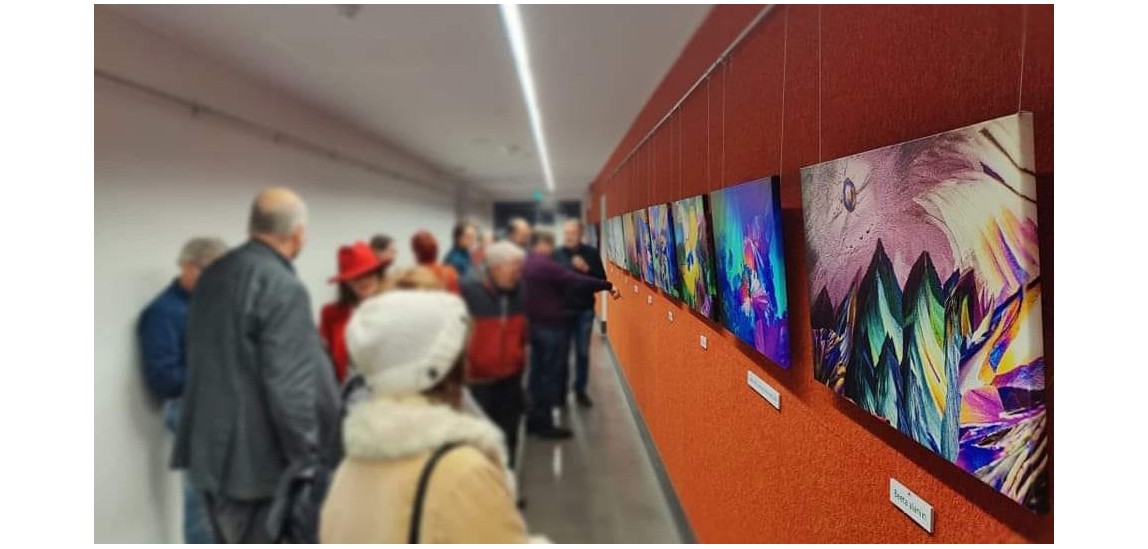Discovering the hidden world through microscopic art

Our photographer Janek Lass's recent exhibition 'Hidden World' at the Physicum Gallery attracted attention with its extraordinary approach to photography. Art critic and historian Krista Piirimäe visited the exhibition and shared her thoughts in Tartu Postimees. Inspired by her review, we'll take a closer look at how Janek Lass opens a door for us into a microscopic universe where ordinary chemical compounds transform into works of art.
Janek Lass: Exploring the Hidden World Through Microscopic Art
At the intersection of science and art, photographer Janek Lass has carved out a unique niche. His recent exhibition "Hidden World" at the Physicum Gallery pushed the boundaries of visual perception and challenged our understanding of both photography and abstract art.
A Colorful Enigma
At first glance, visitors to the exhibition might have been startled by the intense, rainbow-like palette of Lass's works. "Ghastly colors!" one might spontaneously exclaim. However, as Jaak Kikas, the gallery curator and emeritus professor at the University of Tartu's Faculty of Science and Technology, reassures visitors: "These colors were not created by human hands, but by nature itself."
The Artist's Mysterious Approach
What sets Lass apart is his approach to his craft. Unlike many artists who eagerly explain their work, Lass maintains an air of mystery. When questioned about the intricate patterns in his pieces, such as the butterfly-like forms in "Tartaric Acid" or the sun umbrella shapes created by citric acid, his response is a simple, "I don't know."
This enigmatic stance extends to his very identity as an artist. When asked if he considers himself an artist and if his work qualifies as art, Lass's response remains consistent: "I don't know." This refreshing humility and openness to interpretation add an intriguing layer to the exhibition.
The Science Behind the Art
Despite the artist's reticence, the science behind these captivating images is fascinating. Lass's process involves placing chemical solutions on glass plates. As the liquid evaporates, crystals form, creating unrepeatable patterns and structures.
The vivid colors emerge through a technique called polarization microscopy. While our eyes cannot directly perceive light polarization, polaroids make these hidden properties visible through stunning color effects. The resulting hues depend on the wavelength of light and the orientation and thickness of the crystals.
The Interplay of Chance and Technique
What makes Lass's work truly unique is the marriage of chance and technique. No two images are ever the same, much like snowflakes. This unpredictability results in a diverse array of forms – from mountain-like structures to phantom-esque shapes floating across the frame.
Beyond Art: Practical Applications
Interestingly, the technology behind Lass's art has practical applications. Polaroids and polarization microscopy are used in liquid crystal displays (think mobile phone screens) and various scientific research fields.
An Interactive Experience
At the exhibition opening, curator Jaak Kikas offered visitors a hands-on demonstration. Using two polaroid plates with a common transparent plastic bag between them, he showed how these seemingly ordinary materials could transform into a colorful spectacle when viewed through polarized lenses.
Conclusion
Janek Lass's "Hidden World" was more than just an art exhibition. It served as a gateway into the unseen realms of our world, where science and art converge to create something truly extraordinary. Whether or not Lass considers himself an artist, his work certainly provokes thought, wonder, and a renewed appreciation for the hidden beauty that surrounds us.
For an in-depth review of the exhibition by art historian Krista Piirimäe, click [HERE].

.png)





Comments
No comment at this time!
Leave your comment